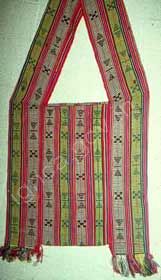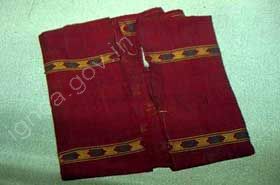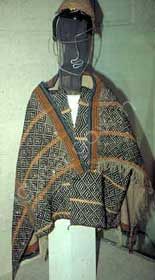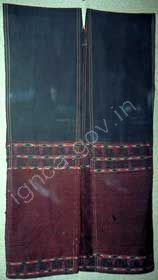Janapada Sampada
Textiles of Arunachal Pradesh
It is not known when the people of Arunanchal Pradesh learned the art of weaving. According to one of the legends, the art of weaving was learnt in a dream from the goddess Podi Barbi. A Galo song narrates a full story of how the cotton is grown, plucked, spun and how it is woven with cotton yarn in a loom. The song, which is sung with the dance by the village girls, narrates that in the olden days when the cotton was not grown and the people had not enough clothes, they started the cultivation of cotton. Thus weaving among the people of Arunachal Pradesh is as old as the story itself. The people knew of clothes as a means of protecting themselves against the rigours of the climate. The women of this area are good weavers and they have a good colour choice and artistic designs of their own.
The colour and design have their symbolic meaning among some of the tribes of Arunachal Pradesh. The use of certain kinds of clothes and ornaments is often associated with a family’s social position and achievements in the fields of hospitality and war. Though there has not been much external influence on the designs of the fabrics in Arunachal Pradesh there has been some borrowing of motifs from the neighbouring areas. The motifs, designs and patterns, however are quite complex and their symbolic meaning and usages are rather significant. The elaborate processes of spinning, dying and finally weaving remind us of the rich discoveries of the women, who were supposed to weave respective clothes for their families.
The work of seed cleaning is a tedious process which is done either by the old women or by a cotton ginning machine consisting of two wooden rollers geared to revolve in opposite directions and turn by the crack with the right hand. The clean cotton is gently rolled hand with the help of round stick over a flat stone or plank into saucessages. This cotton is ready to be spun into thread with the help of a primitive spindle. It consists of a pin of bamboo sticks tapering into fine point at the top and about the thickness of a pencil near the bottom. Once the threads are ready into yarn, the dying process takes place after the yarn is transferred into skeins. Dying of clothes or threads is exclusively performed by women and during this period it has been refrain from sexual inter courses and must not eat beaf, dog flesh, goat’s flesh, dried fish and other food with strong smell.
Textile patterns of the various tribes of Arunachal Pradesh

Bag, Adi Tribe
The Adis concentrate on simple lines. The Adis have great variety of patterns such as there are arrangements of red and black stripes on a white background; white and yellow stripes on a black ground; alternate bands of red and black or of olive-green and brown; broad border-bands of brown with a central narrow stripe of black and white, the body of the cloth being with brown and white stripes at three inch intervals. The Adi bands, whether vertical or horizontal, are often enhanced by a sort of hatching- rows of coloured dots, frets and single lines of different colours. Tiny vertical bars of red and black serve as space-fillers in the horizontal bands or even the narrow stripes. Different shades are achieved by mixing threads of black with other colours, and by closer or looser weaves.

Jacket Adi Tribe
Unmarried Adi girls wear a type of belt, married women wear another. Among some of the Adi, groups there are special clothes for shamans, both men and women which are used only on ceremonial occasions.

Apatani Male dress
The Apa Tani concentrate on simple designs and simple straight lines. The ordinary Apa Tani cloth gets in effect from a use of broad bands alternating with narrow lines, nearly always horizontal. On a general base of blue-green, there may be, along the top and bottom borders, a series of bands varying from a quarter of an inch to nearly an inch in breath, and these themselves have narrow red lines running through them. Within these borders, there are a large number of red lines woven to resemble frets, and down the center are narrow bands of black, green and yellow with red threads. Another style of cloth is white with borders of blue mixed with red lines and a few vertical stripes of red, green and white.
There are hardly any curvilinear designs in tribal weaving, but in the remarkable Apa Tani, priest’s shawl there is genuine spirals, some of which are actually curved. In general however, curves and wavy lines, which may be alternating upright and pendent triangles. There is a herring-bone design on the Apa Tani Priest’s shawl. Although Apa Tani weaving is simple and straightforward, there is an attractive men’s coat, black in colour and decorated with an over-all pattern of white diamonds and orange stripes interconnected and enhanced in various ways.

Mishni female dress
Mishmi weaving is more elaborate, though here too the straight line and band is in frequent use. In Tuensang, the most characteristic shawls generally have an essential deign of stripes and bands of contrasting blacks, reds and blues. The commonest Konyak skirt gains its aesthetic effect by a combination of a large number of narrow horizontal lines of red, black and white set at varying distances from each other, or by alternating red bands with groups of black, yellow and white lines. These single or multiple line and band motifs are the simplest of all and naturally the easiest to weave, sometimes they serve as borders for more complicated designs; sometimes they form the entire pattern in their own right. In their simplicity and directness, there is something very satisfying, and by the rhythm of frequent repition, they produce an effect not unlike that of the rhymed decasyllabic couplet in verse. This may not always reach the heights of the romantic lyric, but is a very serviceable means of conveying ideas. It is among the Mishmis especially the Idu Mishmis that diamond designs have been brought to the highest degree of elaboration. They are woven on shawls, skirts, coats and bags, diamond within diamond, diamond plain and diamonds decorated, diamonds arranged in every possible combination.

Bag, Mishni Tribe

Jacket, Mishni Tribe
These designs in which the diamonds huddle, as it were, within each other seem to symbolize the strongly introverted Mishmi temperament, which draws within itself and is lacking in a social consciousness. There is an Idu Mishmi border design of alternating triangles, each with internal repition. Rows of opposed triangles meeting at the tips and forming lozenges between them are a common feature of Mishmi coats. In inexpert hands, these pairs of triangles get separated and look like hourglasses or cane stools.
The cross is a popular design among the Mishmis. On Taraon Mishmi bags and skirts, a grid pattern is so coloured to form crosses composed of five squares.
The designs of Kaman and Taraon Mishmis are of extraordinary variety. In the Khanlang Valley where every one of the five hundred inhabitants are clothed from head to foot in hand woven cloth, not even a single pattern is exactly duplicated. Some designs are interpreted as a frog, the human figure with head, a narrow waist and legs, the head of a Dao, an eye, scales of fish, clouds trailed across the sky, a river and the rainbow. A row of chevrons signified the marks on the body of a snake, and the interesting pattern of rows of very small pink triangles with a white filling represented teeth visible when the lips are parted in a smile. The very diamond design, traditionally initiated by divine invention, is sometimes related to the markings on the cobra, and the eye design may possibly have evolved from the ‘spectacles’ on its hood.
Aeroplanes are a familiar object all over the frontier. The Kaman Mishmi textiles the aeroplane designs are fully integrated.

Ceremonial skirt, Mishni Tribe
The Wanchoos allow only members of the chiefs’ family to wear a certain type of blue head on the arms and legs and have special design for their headbands. There are certain kinds of bags that can only be carried by members of a headhunter’s family. The designs found on the Wancho bags are triangles closely associated with grid and diamond patterns.
The Zigzag patterns are very common on the Wancho bags. They are made in rather loud and gaudy colours. The Zigzag designs among the Wancho are said to represent the natural aggressive and forceful temperament of the Wanchos. On the Wancho, bags the herring-bone designs are also found. The Lozenge or the diamond patterns are found on the Wancho bags. They are either found in horizontal rows and linked together or as unconnected pieces, when they may represent leaves. Triangles are, of course, closely associated with grid and diamond patterns but they often occur by themselves. They are found rarely on the Wancho bags. Human figures are rarely woven. They are shown rather realistically on Wancho bags and sashes where the simple geometric designs are certainly associated with head hunting.
On the Hrusso bags, a Chinese fence design is made the Hrussos say that it represents the Jana flower. This flower is said to have been named after a great Tibetan Raja, so great that he had the power of talking to the sun. He had an enormous palace opens on all four sides, and could accommodate the sun within it. Everyday he was born at the rising of the sun; by midday, he grew into a youth: by evening he was old and went down with the sun into darkness. The next morning he was born again. When he left the earth, the many coloured Jana flower sprang up in his place.
Among one of the popular designs of the Hrussos is the sun surrounded by its corona. The story behind this is that when the sky and the sun were first made it was very hot, so the god made the clouds to give men shade. When sunshine is needed, the clouds give the sun food to please him and persuade him to shine brightly: this food is the corona represented by the horizontal lines extending from the central body of the design.
Not everybody could wear any cloth among the Hrussos. Among the Hrusso aristocracy alone could wear the Tibetan knobbed hat, and in the past, there were restrictions and the use of the use of silk.
The Sherdukpen women are skilful weavers. There is no fixed place for weaving, nor a fixed structure required, for their loom is simple, light and portable. The articles woven are mainly attractive coloured bags with geometrical designs and rectangular pieces of cloth called Bogre, which are used for carrying things. The yarn is obtained from the plains or is manufactured locally from the bark of plants known as hongchong and hongche. The local yarn prepared from hongche is strong and is used for making fishing nets and bowstrings. The bark of hongchong is poisonous, and as such, women cover their hands with cloth when removing the bark, which is then soaked in boiling water, and washed several times until it decomposes and becomes pulpy.
Among the Sherdukpens the some of the designs revolve around some of the stories of tales like on the popular ones narrated is that “ a girl falls in love with a snake, who is a handsome youth in disguise. In his snake form he coils himself in her lap as she weaves; she copies the markings on her lover’s body and is soon making the most beautiful cloth that was ever seen”. Among the other popular designs among the Sherdukpens are the stylized peacocks carrying a baby bird on the back, the elephants with riders, and flowers that are combined with geometric forms.
The Sherdukpens wear a bogre cloth over the shoulder and serves as a sort of knapsack. Its central motif is always a right-pointing swastika, round which are a number of subordinate patterns which vary considerably. The colours are
red, blue, black and sometimes green and yellow on a white ground. Most of the weavers have forgotten the meaning of these symbols, but a few of the older women remember them; their interpretation varies from village to village. Several of these designs were either interpreted as flowers or as shrubs which supplies the black juice used for painting beauty-marks on the faces of young girls. The lines projecting from the main design are said to be the thorns of the plant. A Chinese fence design is generally used as the upper border of the Sherdukpen bags. The Sherdukpens explain this as the fence dividing their country from China.
The women dress themselves in loose, collarless and sleeveless shirts, which cover the body from shoulders to knees. Over it they sometimes wear small full-sleeved coats made of mill-cloth. Like men women also tie a coloured sash, known locally asmuhkak, round their waist. Sherdukpens generally go bare foot, but sometimes use Monpa shoes. Some Sherdukpens, especially those who have come in contact with the outside world, have given up a part of their original dress, and are now wearing coats, collared shirts, woollen pyjamas and canvas shoes.
The Tuensung shawls have a grid pattern. In Tuensung, the most characteristic shawls generally have an essential design of stripes and bands of contrasting blacks, reds and blues. In Tuensung, colours and designs have their symbolic meaning. The small red squares on the shawls are said to represent the ferment used in making rice-beer. Sharply pointed triangles are arrows or hornbills. Circles of cowries stitched on a cloth symbolize human heads. The red goats’ hair so often used, like the red goats’ hair on dao-handles or sashes, represent the fire which destroys an enemy’s village: trefoil and quatrefoil groups of cowries represent the stars, for raids are undertaken at night by the light of the moon and the stars. The red colour of the shawls is explained for the blood of enemies: blue stands for the sky, black is the night.
In Tuensung where in the past a man’s social position depended so largely on his success in headhunting and in giving feast of merit, this dress-poctocol has great importance.
The Pailibos use separate dress for daily wear and for festive occasions. Besides, they have special pieces of dress for winter, rains and for hunting and formerly for war. The male dresses include Kedu– a sleeveless, button less coat for daily wear. Sisak Kedu– a white sleeveless and button less coat for daily use. Sab-Ki– lion cloth made of cotton. Nara– a fiber piece hanging from the shoulders covering the back for protection from rain. Namu– a woollen sleeveless and button less coat with cutting to put the neck through. It is used during the winters and during hunts. Jepu-Sube– a winter woollen coat. The female dresses include Jepo– a skirt of cotton, woven by them in mixed colours or stripes. Jeli-Jebor– a woollen blouse for use during winter.
Eje-Serak– a belt made of yarn with artistic patterns used on festive occasions. The others are Tayen- Soba and Tari-Lisup. A male child goes out without any clothes until he enters boyhood. He is then given a lion cloth and after some time a loose coat. A female child wears a small cloth round the waist as soon as she is able to attend to some petty errands. The Pailibos have certain ceremonial dresses like Jeli-Sube– a red woollen coat for festive occasions or during visits to other villages or during winter. Jemu-Sube- a woollen coat of maroon colour also used on the above occasions. The others include Tayen-Seak, Sopin-Dumlop. Sotum-Dumloop, Dumlop, Atak, Lakbu, Lub-Bin, Tal-Gor etc.
Weaving is a traditional occupation of the Singpho women, and they are well versed in this art, as in the art of dyeing. A Singpho house is incomplete without the loom in the front of it. All the women irrespective of their age excepting of course the young children, know weaning. They grow cotton in their house and spun the yarn themselves. They use lion loom similar to those of the Khampti looms. Their most favourite yarn is Assamese ‘ Muga” purchase cotton yarn to weave their everyday use clothing’s. But the dress made of muga yarn are costly and so they use such dresses during ceremonial occasions only. Their favourite colours are red, black, green and violet.
The Singphos make their dress themselves, and even now with the exception of a very few of them, all use home made dress. The men’s dress consists of a lungee, woven in cheques, with yarns of various colour, a jacket and a turban. The men’s lungees are of three different kinds:
1. Patep: woven with red and black yarn. The quality of white yarn is more.
2. Bamo: made of Muga yarn of bottle green, violet sky blue, black and green colour.
3. Pachang: made of black, violet, white and green yarn.
The Singpho men wear their hair long, and tie it in a knot on the top of the head, when they wear the turban.
The dress of the women consists of a beautiful designed scarf, a waistband, and a turban. The women skirt is called Pukang. There are different kinds of skirt they weave, which have different names, depending on the size of the stripes and the colour of the yarn. The different skirts are:
1. Mikheng Pukang: woven in red, black and green yarn. The red and balck stripes are broad then the green ones. The texture of the cloth of coarse.
2. Mathat Pukang: the ground of the cloth is black with intermediary thin white stripes.
3. Mukiya Pukang: the ground is black and thin stripes of green and violet. It is of Muga Yarn, and is used only on ceremonial occasions only.
The Singphos do not have separate ceremonial dress, but in marriage the bride and the groom, put on a huge long cloak over their dress, decorated with beautiful design. They do not make it themselves nut purchase from Burma. It is also an item included in the bride price.
Thus the different tribes of Arunachal Pradesh have different weaving patterns and designs having their own symbolic meaning and a legend behind them.




